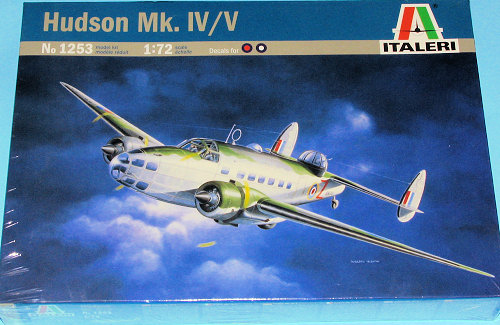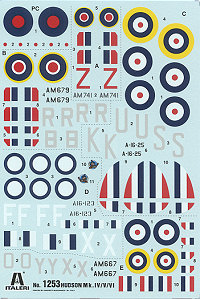
| KIT: | Italeri 1/72 Hudson Mk IV/V |
| KIT #: | 1253 |
| PRICE: | $22.45 from GreatModels |
| DECALS: | Six options |
| REVIEWER: | Scott Van Aken |
| NOTES: | Reboxed MPM kit |

| HISTORY |
In 1938, the British sought an American maritime patrol aircraft to support the Avro Anson. On 10 December 1938, Lockheed demonstrated a modified version of the Lockheed Model 14 Super Electra commercial airliner as the Hudson Mk I, which swiftly went into production. This order for 200 aircraft was the first major order for Lockheed and started them on their road to success. By February 1939, Hudsons began to be delivered, initially equipping No. 224 Squadron RAF at Leuchars, Scotland in May 1939. By the start of the war in September, 78 Hudsons were in service.
A total of 350 Mk I and 20 Mk II Hudsons were supplied (the Mk II had different propellers). These had two fixed Browning machine guns in the nose and two more in a Boulton Paul dorsal turret. The Hudson Mk III added one ventral and two beam machine guns and replaced the 1,100 hp Wright Cyclone 9-cylinder radials with 1,200 hp versions (428 produced).
The Hudson Mk V (309 produced) and Mk VI (450 produced) were powered by the 1,200 hp Pratt & Whitney Twin Wasp 14-cylinder two-row radial. The RAF also obtained 380 Mk IIIA and 30 Mk IV Hudsons under the Lend-Lease program.
In 1941, the USAAF began operating the Hudson; the Twin Wasp-powered variant was designated the A-28 (82 acquired) and the Cyclone-powered variant was designated the A-29 (418 acquired). The US Navy operated 20 A-28s, re-designated the PBO-1. A further 300 were built as air-crew trainers, designated the AT-18.
The Hudson achieved some significant feats during the war. On 8 October 1939, over Jutland, a Hudson became the first RAF aircraft to shoot down a German aircraft. (The accolade of the first British aircraft to shoot down a German plane went to the Blackburn Skua of the Fleet Air Arm on 26 September 1939.) They operated as fighters during the Battle of Dunkirk. A PBO-1 Hudson of USN squadron VP-82 became the first US aircraft to destroy a German submarine when it sank U-656 southwest of Newfoundland on 1 March 1942. Hudsons were operated by RAF Special Duties squadrons for clandestine operations; No. 161 Squadron in Europe and No. 357 Squadron in Burma. They were used as patrol bombers in the Pacific war by the USN and also the RNZAF and RAAF. They also became the first plane to fire a shot in the Pacific Campaign by sinking a Japanese navy transport ship, the IJN Awajisan Maru, just off the coast of Kota Bharu, an hour before Pearl Harbour.
A total of 2,584 Hudsons were built. They began to be withdrawn from frontline service in 1944.
The type formed the basis for development of the Lockheed Ventura.
| THE KIT |
 I've
been told that this is actually an MPM kit that has been reboxed by Italeri. OK,
I can accept that. The kit itself is actually nicely molded with crisp engraved
panel lines and other detail. I did notice quite a few sink areas, mostly on
small parts like the Fowler flap track extensions on the trailing edge of the
wings, some of the interior bits and other pieces that are somewhat thick. This
is is not unusual with an MPM kit and something that most of us who build these
kits have come to expect. It isn't horribly wide spread, but you'll still have
to fill most of them as the parts will be visible. I should also mention that my
kit was missing a propeller blade as you can see by the large blank area in the
upper central sprue. The Italeri website has a contact page, but any attempt to
send them an e-mail using it resulted in an error. Perhaps Italeri's way of not
having to worry about such bothersome things as customer feedback, or it could
be a glitch they don't realize they have. Anyway, I used snail mail to ask for a
replacement. After about 6 weeks, a replacement part arrived via MRC, the
current US importer.
I've
been told that this is actually an MPM kit that has been reboxed by Italeri. OK,
I can accept that. The kit itself is actually nicely molded with crisp engraved
panel lines and other detail. I did notice quite a few sink areas, mostly on
small parts like the Fowler flap track extensions on the trailing edge of the
wings, some of the interior bits and other pieces that are somewhat thick. This
is is not unusual with an MPM kit and something that most of us who build these
kits have come to expect. It isn't horribly wide spread, but you'll still have
to fill most of them as the parts will be visible. I should also mention that my
kit was missing a propeller blade as you can see by the large blank area in the
upper central sprue. The Italeri website has a contact page, but any attempt to
send them an e-mail using it resulted in an error. Perhaps Italeri's way of not
having to worry about such bothersome things as customer feedback, or it could
be a glitch they don't realize they have. Anyway, I used snail mail to ask for a
replacement. After about 6 weeks, a replacement part arrived via MRC, the
current US importer.
The kit supplies an adequate cockpit with enough bits
in there to look convincing. Detailers will have room to add even more stuff.
There are some separate bits to fit on the sidewalls and a nice radio rack and
navigator's station. These will probably be lost once the fuselage halves are
glued together, but some will be visible through the transparencies, which are
nicely done a quite clear. The wheel wells have nicely done detailing in them.
Wheels seem rather plain, but that is how they were. The k it
provides the correct 14 cylinder two row radials and you also have the single
row 9 cylinder engines and cowlings on the sprues, though they are marked as
unused for this version. Two types of upper turret housing are given, though
again, only one is appropriate for this version. There is a separate nose,
leaving room for additional variants to be done. Two types of prop treatment are
provided, one with a plain hub and another with a spinner, depending on the
markings option that one chooses.
it
provides the correct 14 cylinder two row radials and you also have the single
row 9 cylinder engines and cowlings on the sprues, though they are marked as
unused for this version. Two types of upper turret housing are given, though
again, only one is appropriate for this version. There is a separate nose,
leaving room for additional variants to be done. Two types of prop treatment are
provided, one with a plain hub and another with a spinner, depending on the
markings option that one chooses.
The instructions are all we've come to expect from Italeri with a nice parts diagram, color info in generic, FS 595 and Model Master reverences and superbly drawn construction steps. Another thing we have come to expect from Italeri kits are a good variety of options and this one is no exception. First is the box art aircraft from 500 Sq RAF in 1943 coastal command colors of Dark Sea Grey and Dark Slate Grey over white. In similar colors but with a Sky underside is another plane coded RR*B from 407 Sq RCAF (thanks for the info, Tom). Moving to Dark Green/Dark Earth over Aluminum, we have a 1 Squadron RAAF bird from 1941 in Malaya (the instructions say Malaysia, but that country did not exist in 1941). From Milne Bay in New Guinea during 1943 is a 6 Sq RAAF plane with the same colors as previous, but with a Medium Sea Grey underside and later roundels. Finally, from 48 Sq RAF in 1941 is a Dark Green/Ocean Grey over Medium Sea Grey aircraft. In all a wide selection of units and camouflage schemes. The decals themselves are nicely printed and should work quite well.
| CONCLUSIONS |
Those of you hoarding your Airfix Hudsons now have a more modern, and probably better fitting option. I'm looking forward to giving this one a go should things work out well. I'm sure you'll be as pleased to have this kit as am I.
| REFERENCES |
Wikipedia and the internet.
December 2006
You can find this and many other great kits at GreatModels
If you would like your product reviewed fairly and quickly by a site that has over 325,000 visitors a month, please contact me or see other details in the Note to Contributors.